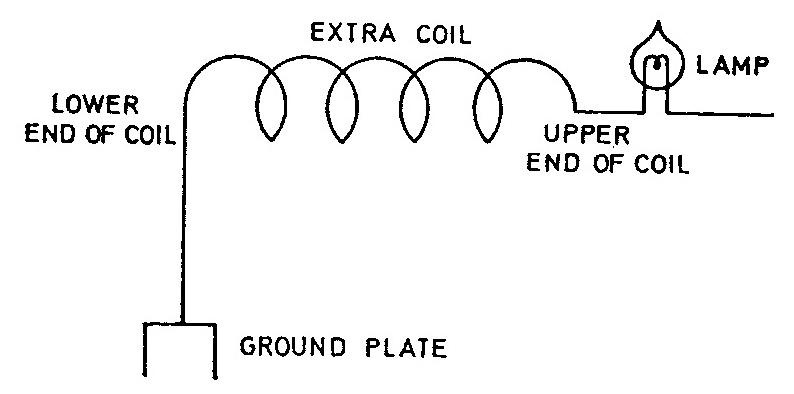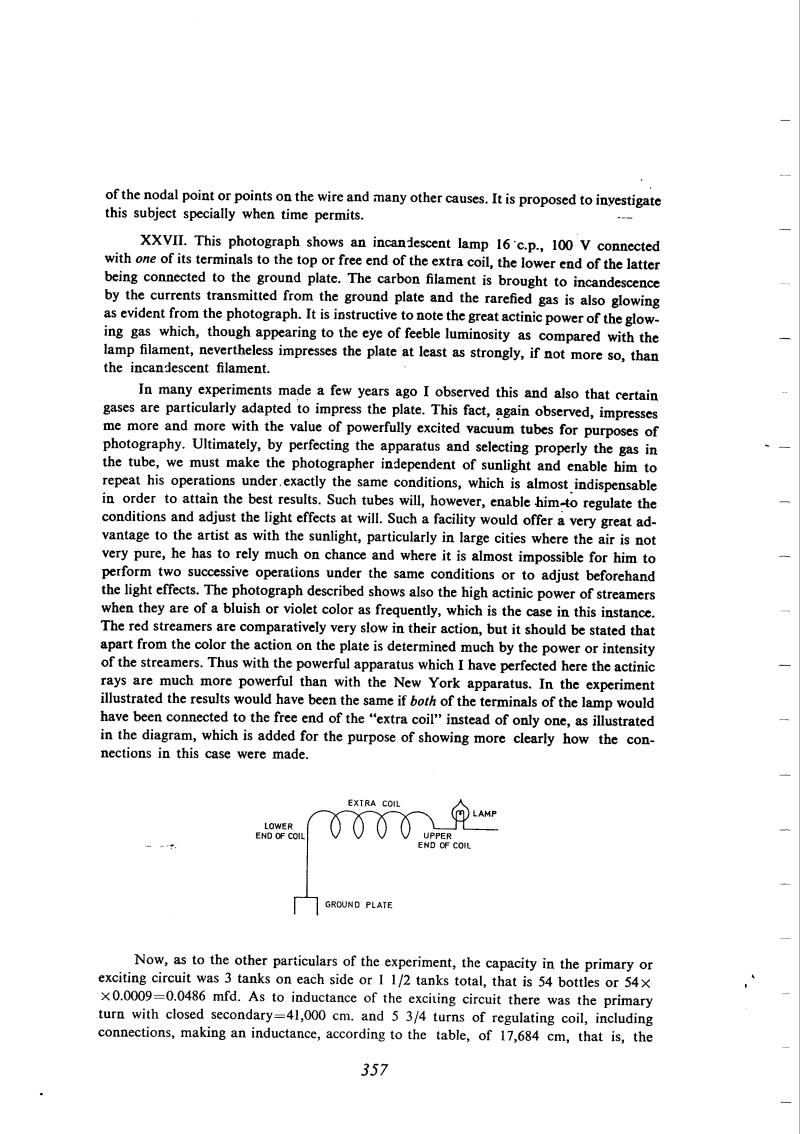
Nikola Tesla Books
XXVII. This photograph shows an incandescent lamp 16 c.p., 100 V connected with one of its terminals to the top or free end of the extra coil, the lower end of the latter being connected to the ground plate. The carbon filament is brought to incandescence by the currents transmitted from the ground plate and the rarefied gas is also glowing as evident from the photograph. It is instructive to note the great actinic power of the glowing gas which, though appearing to the eye of feeble luminosity as compared with the lamp filament, nevertheless impresses the plate at least as strongly, if not more so, than the incandescent filament.
In many experiments made a few years ago I observed this and also that certain gases are particularly adapted to impress the plate. This fact, again observed, impresses me more and more with the value of powerfully excited vacuum tubes for purposes of photography. Ultimately, by perfecting the apparatus and selecting properly the gas in the tube, we must make the photographer independent of sunlight and enable him to repeat his operations under exactly the same conditions, which is almost indispensable in order to attain the best results. Such tubes will, however, enable him to regulate the conditions and adjust the light effects at will. Such a facility would offer a very great advantage to the artist as with the sunlight, particularly in large cities where the air is not very pure, he has to rely much on chance and where it is almost impossible for him to perform two successive operations under the same conditions or to adjust beforehand the light effects. The photograph described shows also the high actinic power of streamers when they are of a bluish or violet color as frequently, which is the case in this instance. The red streamers are comparatively very slow in their action, but it should be stated that apart from the color the action on the plate is determined much by the power or intensity of the streamers. Thus with the powerful apparatus which I have perfected here the actinic rays are much more powerful than with the New York apparatus. In the experiment illustrated the results would have been the same if both of the terminals of the lamp would have been connected to the free end of the âextra coilâ instead of only one, as illustrated in the diagram, which is added for the purpose of showing more clearly how the connections in this case were made.
Now, as to the other particulars of the experiment, the capacity in the primary or exciting circuit was 3 tanks on each side or 1 1/2 tanks total, that is 54 bottles or 54 x 0.0009 = 0.0486 mfd. As to inductance of the exciting circuit there was the primary turn with closed secondary = 41,000 cm. and 5 3/4 turns of regulating coil, including connections, making an inductance, according to the table, of 17,684 cm, that is, the
The explanation to Photograph XXII concerning the transmission of power from the excited primary circuit to the âextra coilâ via the earth is similar to that he gave in 1893(6). The experiment to which the photograph refers was made with the aim of estimating the power of the oscillator from the thermal effect of the HF current. What Tesla calls the âtotal energy set in movementâ would correspond to the total energy transferred to condenser in the secondary (i.e. the power) if an energy of $!{1 \over 2}$! CV2 is transferred in each half-cycle. It can be shown that the active power dissipated in the circuit is much less than this and is inversely proportional to the Q-factor of the oscillating circuit.
January 2
Tesla gave his observations on 22 pages. On them he described eleven photographs. The explanation along with photograph No. 22 about energy transmission from excitation of the primary circuit to "additional coil" over the earth surface is similar to the one from 1893(6). Otherwise the experiment to which the photograph is related was performed for the purpose of oscillator power estimate on the basis of thermal effects of high frequency current.
That which Tesla calls "total energy placed in motion" would correspond to the total energy which is supplied to a capacitor per second (i.e. power) if energy ½CV2 is supplied during the duration of one half of the period.
It could be shown that the active power which is spent in the circuit is considerably smaller than this power, and opposite, proportionally to the quality factor of the oscillating circuit. On several following photographs, the movable resonant coil with connected bulbs is photographed which is supplied by transmitted high frequency energy. One terminal of this coil is connected to the ground, and the other is open ended or a short piece of wire is connected to it. Bulbs are coupled by means of the auxiliary secondary coil inductively with the secondary coil. The data was not given on the distance of resonant coil from the oscillator coil. Tesla's comment on photograph No. 27 illustrates the interest on the question of electrical lightning, though he worked on this for more than ten years. One earlier discovery on gas elimination and not only filament, when working with high frequency currents is again proven(5).
On photograph No. 28 the bulb is connected in series with a terminal capacitance load. In the calculations "total energy placed in movement" is not taken when it was assumed that the electrostatic energy ½CV2 is spent in the bulb during one half of the period. A similar comment is valid for photograph No. 29.
Tesla mentioned several times that the main transmission from the exciting to the excited circuit is done via the ground. The proof for this statement he found in the experiment illustrated by photograph No. 30. He concluded that the induced voltage in the excited circuit is significantly reduced when the ground connection is disconnected. Photograph No. 31 is an X-ray photograph of a finger. The comments on this experiment are an illustration of Tesla's interest in the radiation field which was mentioned earlier (please see comment on June 6, 1899).


